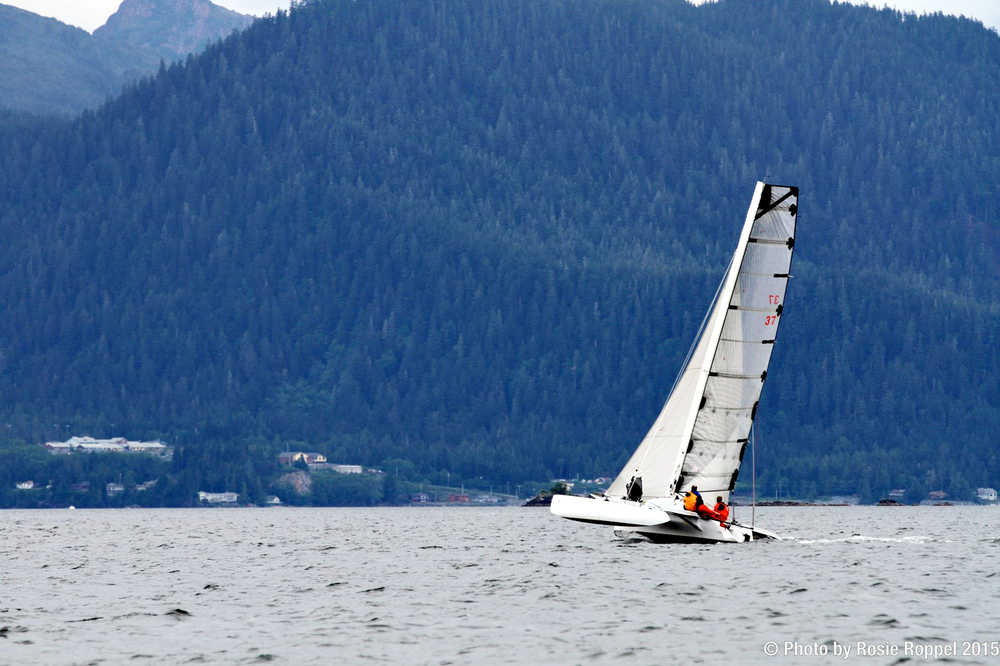Team Elsie Piddock sailed into Ketchikan harbor, and small boat history, to win the inaugural Race to Alaska boat race Friday 100 miles ahead of the nearest competitor.
People are running out of superlatives for Elsie Piddock’s 710-mile leg from Victoria, B.C. to Ketchikan in 5 days, 55 minutes: “Crushed it!” “Greased it!” “Jaw dropping!” Pick a phrase for awesomeness.
Race to Alaska, or R2AK, North America’s longest human-and-wind-powered race, officially began in Port Townsend, Washington on June 4, with more than 50 teams headed up the coast toward the finish line in Ketchikan. 750 miles and only three rules: no motors, no supply caches, no support vessels. That’s it.
First prize, claimed by Elsie Piddock, was $10,000 nailed to a tree in Ketchikan. Second prize is a set of steak knives. Everyone else is guaranteed a T-shirt and epic sea stories.
At press time, boats are spread out over 400 miles of the route; trimarans, a six-man paddling canoe playing German language lessons on a loud speaker, a dory, a Polynesian fusion craft with a pedal driven propeller, a kayak with sails.
Every boat carries a Spot tracker which means for the next few weeks, you can follow them, check the winds, make bets etc. The race website, r2ak.com, also has pictures, commentary and daily updates.
There’s no official course but everyone has to pass two waypoints. The first is at the tidal currents of Seymour Narrows north of Campbell River, B.C. At peak the current can run over 14 knots and suck down logs as big as telephone poles. My pre-race prediction, that winds would be tricky in the Narrows and rowers would gain on sailboats, was way off for the first boats. There’s a picture of Elsie Piddock, with a crewman riding her outrigger float high out of the water, flying up-wind, against the current through Seymour Narrows. Greased it.
The second waypoint is in the First Nations community of Bella Bella, B.C. They know about travelling without motors in Bella Bella. Back in the 1980s they carved the region’s first traditional Northwest ocean going canoe in living memory and villagers paddled it down the Inside Passage to Expo ’86 in Vancouver. People from this friendly community are turning out to greet racers, bring them food and wish them well.
Everyone still in the race made the 40-mile qualifying leg from Port Townsend to Victoria, BC in under 36 hours. Of the 75 teams who signed up, 53 boats actually started on June 4. It was a breezy day, blowing around 20 knots in the Strait of Juan de Fuca which helped the large sailboats skip across in about four hours but hampered small vessels, one of which came in just 30 minutes under the 36-hour deadline.
A total of 40 completed the crossing to Victoria, 11 of those stopped there.
Winds were wild in the first week. Some boats got their masts handed to them. Consistent north/northwest headwinds put racers to the test but with long open stretches and places where mountains act as wind shadows it’s been everywhere between 40 knots and zero. One day, while winds laid sail boats over to the rails in Johnstone Strait, sail boats further back were rowing with no wind at all.
Respect to Team Soggy Beavers, in the six-man Canadian outrigger canoe, who paddled into serious wind five days straight. When things laid down the Canadians left Port McNeil in the morning, crossed Queen Charlotte Sound at night, blasted up the eastern shore in the dark, rounded Cape Caution and headed north at nearly six knots after paddling 24 hours straight.
That’s so over the top I called race Director Jake Beattie to ask if I was reading the tracker right.
He said, “Yeah, they sent me a picture from Port McNeil yesterday.” The Soggy Beavers are all under 25. They have impressive ocean going credentials, a great sense of humor and a hockey stick on board. In light wind they’re the monster crew to watch.
The Race to Alaska has captured international attention. It has the cachet of the Pacific Northwest. It pushes the envelope of small boat design. The event just shouts, “Look Ma. No oil.” It’s not about winning or money. It’s a people’s race more like running marathons, where the satisfaction is in doing it. All you need is the drive, a boat or something like it (one guy signed up with a paddle board), and the ability to convince the coordinators at the Northwest Maritime Center that you’ll probably be able to get yourself out of whatever you get into.
Every boat, last to first, will have its story. Maybe the biggest appeal is the infectious excitement from so many people who are watching this thing and saying, “I want a piece of that action.”
Dick Callahan is a Juneau writer and small boat enthusiast who traveled slowly from Juneau to Seattle in an 18-foot motor-less dory in 2012.

